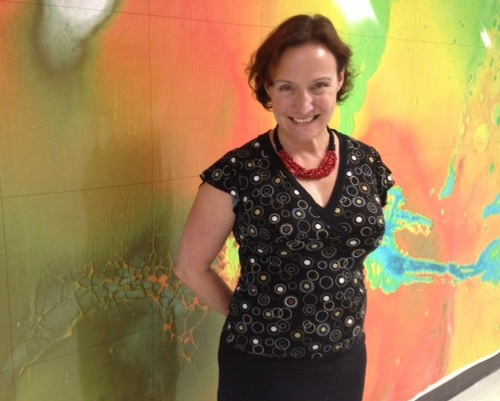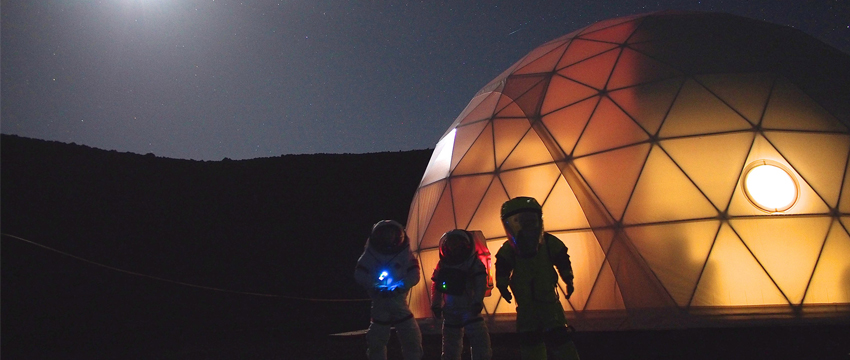In the Oscar-winning movie The Martian, marooned astronaut Mark Watney sends a shout-out from Mars to his alma mater (the University of Chicago). In real life, future Mars explorers may one day send a grateful shout-out toKim Binsted, BSc’91, who is currently leading a NASA-funded research program aimed at preparing crews for long duration space missions.
Binsted is the principal investigator of the Hawaii Space Exploration Analog and Simulation (HI-SEAS) program, overseeing simulations currently taking place on the side of a volcano on the island of Hawaii, 2,500 metres above sea level. The current mission consists of six scientists living and working in total isolation for one year in a 112-square metre geodesic dome consisting of a kitchen, a laboratory, bathroom, simulated airlock and sleeping quarters.
“NASA is systematically checking off all the prerequisites for a long duration mission, and a series of HI-SEAS missions were launched in 2012 to investigate crew composition and cohesion,” says Binsted, a professor in the Information and Computer Sciences Department at the University of Hawaii at Manoa.
The HI-SEAS program is explicitly designed to simulate life on Mars. With its red lava beds, the Mauna Loa volcano site is a good stand-in for the Martian landscape. Crew members live and work in total isolation, leaving their habitat only for short periods of time in simulation space suits. Solar panels provide power, water is conserved and used sparingly, and communication with the outside world is restricted to email and file drop (with a 20 minute delay). There are no phones or Skype, no fresh air and no fresh food.
Among the many technical and logistical challenges inherent in a Mars mission, NASA is particularly interested in behavioural research, focusing on the psychological and psychosocial factors affecting crews for such long duration missions. It’s a key factor, especially considering the travel time between Earth and Mars (eight months, one way). To help explain the challenges of crew cohesion, Binsted channels the opening line of Tolstoy’s Anna Karenina.
“Happy families are all alike, every unhappy family is unhappy in its own way,” she says. “That line is relevant to the HI-SEAS missions. The areas where things go right are similar among all crews, but when things go wrong, it’s particular to each crew.”
But what could possibly go wrong during an eight-month space voyage to an inhospitable planet?

In an article about the HI-SEAS crew, the Toronto Star summed it up with the headline, “Getting to Mars ‘without killing each other.’ ”
Based on previous long duration simulations, even the best crews exhibit personality conflicts, disagreements on how to deal with equipment problems, stress and boredom, resentment towards mission control orders, even instances of selfishness (like mooching the rations of another crew member). After watching The Martian (which she loved), Binsted says she got even more ideas for emergency scenarios to throw at the HI-SEAS crew to see how they would react.
To gather valuable data on such interactions, the crew is monitored using cameras, body movement trackers, electronic surveys, and other methods. In this way, Binsted and her colleagues study the group’s cohesion over time, gathering data on a wide range of cognitive, social and emotional factors that may impact team performance. To date, there have been three HI-SEAS missions of four, eight and 12 months respectively. The current 12 month mission concludes on August 28.
“The longer each mission becomes, the better we can understand the risks of space travel,” says Binsted. “We hope that this mission will provide NASA with solid data on how best to select and support a flight crew that will work cohesively as a team while in space.”
In many ways, Binsted is perfectly qualified to oversee the HI-SEAS program. Besides impeccable academic qualifications (including a PhD in artificial intelligence), she was chief scientist during a four month Mars exploration analog (simulation) with eight other scientists which took place in 2007 on Devon Island in the Canadian High Arctic. It was there that she acquired the unique insights which make her particularly well suited to support the HI-SEAS program.
“For example, in the real world when you send an email and get a response in a week, that’s generally fine,” she says. “But when you’re in an analog and someone doesn’t get back to you within 24 hours, it’s torture. You feel abandoned.”
Then there’s the wildly liberating post-analog experience of going outside without a requisite space suit.
“The first time you step outside without a helmet, it’s like going from sixties black and white TV to high-definition,” she says.
The experience also made Binsted into a savvy recruiter when it comes to selecting suitable long duration simulation participants (she and her colleagues sifted through several hundred applications for the HI-SEAS program). She says successful applicants need thick skins, a long fuse, an optimistic outlook and must be easily entertained.
“If you really need to go out clubbing on the weekends, you’re going to be pretty miserable in an analog of a long duration,” she says.
A good sense of humour is also an invaluable tool for wanna-be Mars explorers and Binsted should know. While at McGill, she honed her comedy chops with McGill Theatresports (now known as McGill Improv). She went on to become a founding member of the comedy troupe On the Spot, performing at such venues as Montreal’s Comedy Nest.
“When I think about the skills that served me best, being able to do improv was a huge part of that,” she says of her McGill days. “It teaches you to think on your feet and also teaches you a whole lot about teamwork.”
Binsted will be coming full circle in September when she returns to McGill for the Steinberg Centre for Simulation and Interactive Learning 10 year anniversary, delivering a public lecture. And, although medical simulation might seem a long way from the HI-SEAS program, Binsted maintains that the core objectives boil down to one key question of equal importance to NASA and the SIM Centre.
“How do you make sure that what you’re getting out of simulation applies to the actual thing you’re trying to experience?” she says.
As part of the Steinberg Centre for Simulation and Interactive Learning 10 year anniversary activities, Professor Kim Binsted will be delivering a public lecture on September 14, 2016 at McGill and also participating in a round table discussion on September 15 at the Centre. Click here for more information.
August 29, 2016

